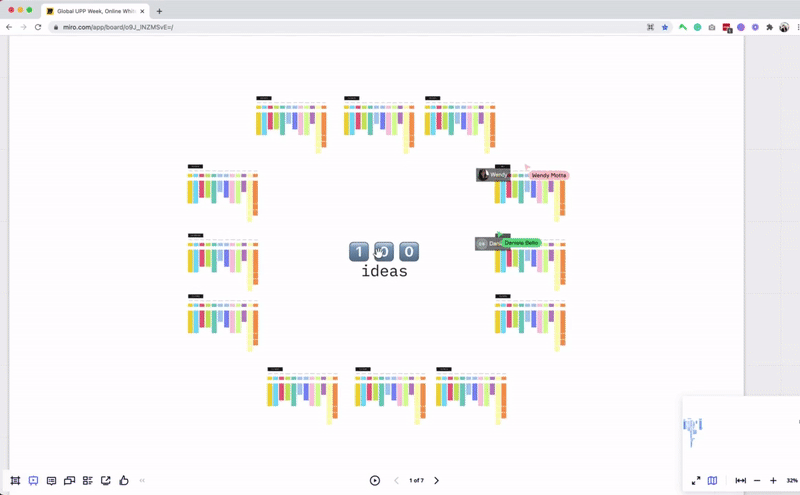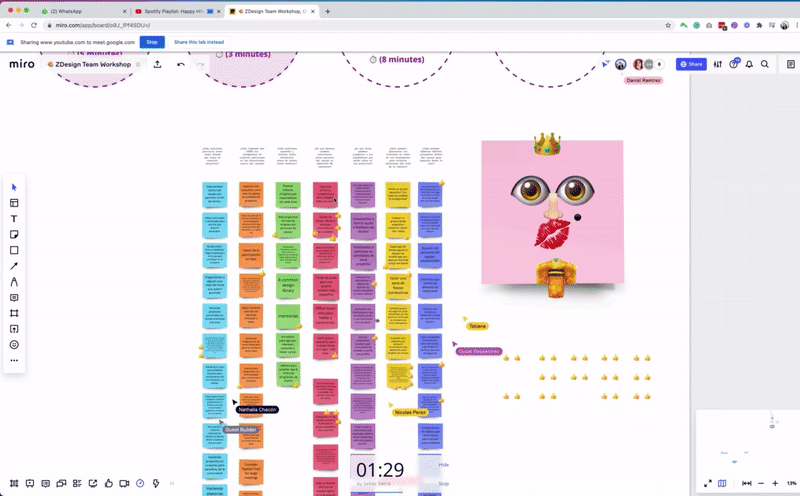At Zemoga, we have learned that we can train our brains and creativity muscles to help us face—with confidence—the next occasion when we are asked to come up with ideas.
Over the years, our team has had several meetings or situations where we need to ideate to solve a problem with an existing product, or to reframe a challenge and define the best way to approach it. And almost every week (sometimes twice or three times a week), we have to get into divergent thinking to help us generate as many ideas as we can.
After exploring, iterating, sometimes failing, and learning from that, we built a secret sauce that has helped us mix ingredients, follow, and cook over 100 ideas. Here’s the recipe in our Miro template.
Yes, we guarantee that by the end of 30 minutes (sometimes less than that), you will have a pot full of 100 ideas: good ideas, great ideas, small ideas, ambitious ideas, but at the end, over 100 ideas you didn't even have 30 minutes earlier. We want to make this recipe available to all of you, so you can add or remove ingredients to make your own process—maybe adding a bit more salt so the flavor suits you? We’re so excited to see what dishes you come up with.
(Did you check out our Miro template yet, or are you still hungry for more?)
Because of the pandemic and remote-friendly workspaces, by scheduling an Ideation Workshop (please do not call it a meeting—but feel free to call it a brainstorming session) and taking advantage of collaborative online tools, like Miro, you will get those promised 100 ideas.
Let the hunger games workshop begin!
💡Recipe: Over 100 ideas in 30 minutes
Ingredients:
- 📆8-12 people: Invite people from your team with different backgrounds. At Zemoga, we have taken advantage of the multidisciplinary teams we have (Tech, Designers, BAs, Management) because it gives different perspectives to the same challenge or problem you are trying to solve.
- ❓Trigger questions: These questions are prompts for creating innovative ideas. They force you and your team to think different perspectives and contexts and develop new solutions around a provocative possibility.
Formulate 8-12 questions that will help others ideate and come up with different solutions.
Here are some examples of how to formulate questions:
How might we question:
- Template: How might we [action what] for [whom] to [change something]
-
Examples:
- How might we facilitate the registration process for users of the site to improve the number of participants by the end of the month?
- How might we develop ideas for first-time users to guide them through the app and the onboarding process?
Keywords combination:
- Template: Your [Brand / Product / Service] + Something else [With a context and out of place ideas]
-
Examples: For a Seasonal Marketing Campaign for Zemoga
- Zemoga + 2020 Summer Olympics
- Zemoga + FIFA World Cup
- Zemoga + Halloween + Costume Party
✏️Miro Board (Come on! Check Out Our Miro Template): Add your questions to the template we have here, and you are all set for the Workshop.
Method: Ideation Workshop

Divergence (30 minutes)
- Explain the challenge or problem you all we’ll be working on.
- Give each participant a spot on the Miro Board: As you will find on the Miro template, we have formed a circle with 12 workplaces, 1 for each of your participants.
- Reveal your cards one at a time: You will be revealing trigger questions every 2-3 minutes. Start with one single question and invite your team to write ideas under that question umbrella.
- Set the timer and turn the music on. For each question, set the timer. We highly recommend giving less time for the first questions and increasing 30 seconds after question # 3. Put some music in the background to motivate participants and to set a focused environment.
- Please invite others to steal ideas: After question # 4, ask participants to look at others’ ideas, and based on other’s sticky notes, reformulate and write new ideas in their workplace.
- And there you have it! In 30 minutes, you have a pot full of 100 ideas!
Again… Check Out Our Miro Template

Facilitation Tips:
- ⚡️Energy is vital: The workshop’s success can depend on making sure your participants feel engaged and switched on! Bring more enthusiasm than you would in an in-person workshop.
- 🎵Background Music: Put on some workshop music to create a friendlier atmosphere. Having some background music can help the workshop feel less lonely and awkward.
- ⏰Timebox everything and push limits: Timeboxing allows you to stop that hesitation mindset once and for all and complete your tasks quickly and effectively. ⠀
Happy the hunger games workshopping!
Seriously...Check Out Our Miro Template!